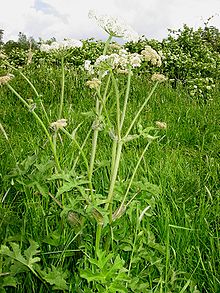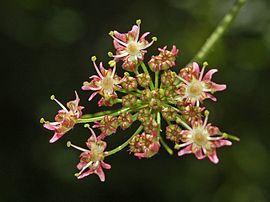- Common Hogweed
-
Common Hogweed 
Heracleum sphondylium Scientific classification Kingdom: Plantae (unranked): Angiosperms (unranked): Eudicots (unranked): Asterids Order: Apiales Family: Apiaceae Genus: Heracleum Species: H. sphondylium Binomial name Heracleum sphondylium
L.Synonyms - Heracleum alpinum subsp. benearnense Rouy & E.G.Camus
- Heracleum alpinum subsp. pyrenaicum (Lam.) Rouy & E.G. Camus
- Heracleum alpinum var. pyrenaicum (Lam.) Pers.
- Heracleum austriacum var. elegans Crantz
- Heracleum ceretanum Sennen
- Heracleum granatense Boiss.
- Heracleum longifolium Jacq.
- Heracleum montanum Schleich. ex Gaudin
- Heracleum panaces sensu Lange
- Heracleum pyrenaicum Lam.
- Heracleum setosum var. granatense (Boiss.) Rouy & E.G. Camus
- Heracleum setosum Lapeyr.
- Heracleum sibiricum subsp. longifolium (Jacq.) Arcang.
Heracleum sphondylium, common names Common Hogweed or Cow parsnip, is a herbaceous perennial or biennial plant of the family Apiaceae. It is an umbelliferous plant, in the same group as fennel, cow parsley, ground elder and giant hogweed. Umbelliferous plants are so named because of the umbrella-like arrangement of flowers they produce.
Contents
Etymology
The genus name Heracleum derives fron the Greek "herákleion" and refers to the mythologic hero Heracles, while the species name sphondylium, meaning "vertebrae" refers to the shape of the segmented stem.
Description
Heracleum sphondylium reaches on average 50–120 centimetres (20–47 in) of height, with a maximum of 2 metres (6 ft 7 in). From large reddish rhizomatous roots rises a striated, hollow stem with bristly hairs. The leaves can reach 50 centimetres (20 in) of length. They are pinnate, hairy and serrated, divided into 3-5 lobed segments.
This plant has pinkish or white flowers with 5 petals. They are arranged in large umbels of up to 20 cm of diameter with 15 to 30 rays. The peripheral flowers have a radial symmetry. Flowering typically occurs between June and October. The flowers are pollinated by insects (usually bees, wasps and flies) (entomogamy) The small fruits are flattened and winged, elliptical to rounded and glabrous, up to 1 cm long. The seed dispersal is by wind (anemochory).
Heracleum sphondylium is smaller in size than the skin irritating Heracleum mantegazzianum (Giant Hogweed).
Distribution
These plants have a Eurasian distribution, growing all over Europe (except Iceland), and North Africa.
Habitat
The plant is common in herbaceous places, along roads, in hedges, meadows and woods, especially in mountain areas up to 2500 m of altitude. It prefers rich in nitrogen, moist soils.
Similar species
The water parsnip (swamp parsnip, sium suave), western water hemlock (Cicuta douglasii, poison hemlock) and spotted water hemlock (Cicuta maculata, spotted parsley, spotted cowbane) all have white flowers in large compound umbels, which can lead to misidentification. All water hemlock and poison hemlock are highly poisonous,[1] but water parsnip is not.[2] Both have clusters of small white flowers shaped like umbrellas, and have the same habitat near the shore line of lakes and rivers. Water parsnip has leaves only once compound, and water hemlock has leaves which are three times compound. Water hemlock has a large swelling at the stem base, and has bracts at the base of each small flower cluster, not at the base of the main flower head.[3] The Water parsnip has small bracts at the base of flowers and main flower head as well.[4] Yarrow from the Asteraceae family,(Common Yarrow, Gordaldo, Nosebleed plant, Old Man's Pepper, Sanguinary, Milfoil, Soldier's Woundwort, Thousand-leaf (as its binomial name affirms), Thousand-seal or Achillea millefolium) also has many small white flowers in a cluster. However the yarrow has feathery looking leaves which are pinnately separated into small narrow segments.[5] The cow parsnip (heracleum lanatum, Heracleum maxinium, Indian Celery or Pushki) is also confused in this group with similar flower groupings. However, the cow parsnip has large, broad leaves, and an unpleasant odour.[6]
Subspecies
This species presents a large variability of the characteristics and the occurrence of many intermediate forms. In Europe there are eight named subspecies.
- Heracleum sphondylium subsp. chloranthum (Borbás) Neumayer
- Heracleum sphondylium subsp. elegans (Crantz) Schübl. & G. Martens
- Heracleum sphondylium subsp. glabrum (Huth) Holub
- Heracleum sphondylium subsp. orsinii (Guss.) H. Neumayer
- Heracleum sphondylium subsp. pyrenaicum (Lam.) Bonnier & Layens
- Heracleum sphondylium subsp. sibiricum (L.) Simonk.
- Heracleum sphondylium subsp. sphondylium
- Heracleum sphondylium subsp. trachycarpum (Soják) Holub
Gallery
References
- ^ "Cicuta maculata.". http://www.em.ca/garden/native/nat_cicuta_maculata.html. Retrieved 2008-08-03.[dead link]
- ^ Kuhnlein, Harriet V; Turner, Nancy J. (1991). Traditional Plant Foods of Canadian Indigenous Peoples. Taylor & Francis. ISBN 9782881244650. http://books.google.ca/books?id=fPDErXqH8YYC&pg=PA124&lpg=PA124&dq=hemlock++saskatchewan&source=web&ots=wEZs3Qy1Nb&sig=4XiR4NlX_41oreXB54L841HnbIs&hl=en&sa=X&oi=book_result&resnum=10&ct=result#PPA124,M1. Retrieved 2008-08-03.
- ^ "Western Water Hemlock - Agriculture - Government of Saskatchewan". http://www.agriculture.gov.sk.ca/Default.aspx?DN=6896bcb3-d202-43e0-ace9-c4ec72d8835d. Retrieved 2008-08-03.
- ^ "Water Parsnip - Agriculture - Government of Saskatchewan". http://www.agriculture.gov.sk.ca/Default.aspx?DN=e2b0945b-6609-4790-ae82-8fdd9135af26. Retrieved 2008-08-03.
- ^ "Yarrow Achillea millefolium". http://www.em.ca/garden/native/nat_Achillea%20millefolium.html. Retrieved 2008-08-03.
- ^ "Heracleum lanatum". University of Saskatchewan. http://www.usask.ca/agriculture/plantsci/classes/range/heracleum.html. Retrieved 2008-08-03.
- Pignatti S. - Flora d'Italia – Edagricole – 1982, Vol. II, pag. 237
- TUTIN, T. G. & al. (ed.) (1968). Flora Europaea. (vol.2) Cambridge University Press, Cambridge. [p.365]
External links
This Apiaceae article is a stub. You can help Wikipedia by expanding it.







